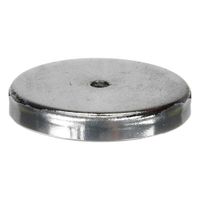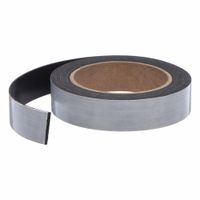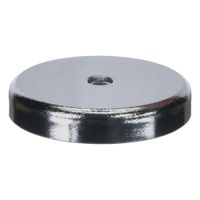Call +(254) 703 030 000 / 751 483 999 / 721 704 777
.....Read More
Frequently Asked Questions
What are the different types of magnets and their uses?
Magnets are materials that produce a magnetic field, attracting or repelling other magnetic materials. They are categorized into several types based on their composition and how their magnetism is produced or maintained.
Permanent magnets retain their magnetism once magnetized. Examples include: * Neodymium magnets: These are the strongest type, made from an alloy of neodymium, iron, and boron. They are used in headphones, hard drives, and magnetic closures.
* Samarium-cobalt magnets: Strong and resistant to demagnetization at high temperatures, they are used in high-temperature applications like motors and sensors.
* Alnico magnets: Made from aluminum, nickel, and cobalt, they are strong and have good temperature stability, often found in guitar pickups and sensors.
* Ceramic (Ferrite) magnets: Less powerful but inexpensive and resistant to corrosion, they are common in refrigerators, speakers, and small motors.Electromagnets are temporary magnets that only produce a magnetic field when an electric current flows through them. They consist of a coil of wire wrapped around a metallic core (often iron). Their strength can be controlled by varying the current. Uses include: * Motors and generators: Fundamental to converting electrical energy into mechanical energy and vice versa.
* Relays and solenoids: Used to control electrical circuits and activate mechanical devices.
* Magnetic levitation (Maglev) trains: Utilize powerful electromagnets for propulsion and levitation.
* Lifting magnets: Used in industrial settings to lift heavy metal objects.Superconducting magnets are electromagnets that can produce extremely strong magnetic fields when their coils are cooled to cryogenic temperatures, eliminating electrical resistance. They are used in: * Medical imaging (MRI machines): Generate detailed images of internal body structures.
* Particle accelerators: Used in scientific research to accelerate subatomic particles.
* Nuclear fusion reactors: To confine plasma at extremely high temperatures.
How do magnets generate a magnetic field?
Magnets generate a magnetic field due to the movement of electric charges. In permanent magnets, this phenomenon is primarily attributed to the intrinsic property of electrons called "spin." Each electron acts like a tiny magnet, possessing a magnetic dipole moment. In most materials, these tiny magnetic moments are randomly oriented and cancel each other out, resulting in no net magnetic field.
However, in ferromagnetic materials like iron, nickel, and cobalt, the electron spins in certain regions, called magnetic domains, align in the same direction. When an external magnetic field is applied, or if the material is subjected to specific manufacturing processes, these domains can grow and align, leading to a macroscopic magnetic field.
Another way magnetic fields are generated is through electric currents. According to Ampere's law, moving electric charges create magnetic fields. This is evident in electromagnets, where an electric current flowing through a coil of wire produces a magnetic field. The strength and direction of this field depend on the magnitude and direction of the current, as well as the number of turns in the coil. Both permanent magnets and electromagnets fundamentally rely on the motion of charges, either at the atomic level (electron spin) or macroscopic level (electric current), to produce their respective magnetic fields.
What are ceramic magnets and where are they used?
Ceramic magnets, also known as ferrite magnets, are a type of permanent magnet made primarily from strontium or barium ferrite. They are hard, brittle, and have a distinctive dark gray appearance. Unlike rare-earth magnets (like neodymium), ceramic magnets are not as strong, but they are significantly more affordable and have excellent resistance to demagnetization, corrosion, and high temperatures. These properties make them a popular choice for a wide range of applications.
Their primary uses include: * Motors: Found in many electric motors, especially in automotive applications (e.g., windshield wiper motors, power window motors) and in appliances.
* Speakers: Crucial components in loudspeakers and headphones, where they create the magnetic field necessary to move the voice coil and produce sound.
* Magnetic Separators: Used to separate ferrous materials from non-ferrous materials in recycling, mining, and food processing industries.
* Crafts and Educational Purposes: Due to their low cost and relatively low strength, they are often used in educational kits, refrigerator magnets, and various craft projects.
* Sensors: Employed in simple magnetic sensors, such as those used in security systems or proximity switches.
* Holding Applications: Used in magnetic catches for cabinets, tool holders, and other light-duty holding applications.Their robust nature and cost-effectiveness ensure their continued widespread use across various industries.
How do rare earth magnets compare to other types of magnets?
Rare earth magnets, primarily neodymium and samarium-cobalt magnets, are significantly stronger than traditional magnets like ceramic (ferrite) or alnico magnets. This superior strength, measured by their magnetic energy product, allows them to generate much more powerful magnetic fields for their size, making them ideal for applications where space and weight are critical, such as in hard drives, electric motors, and headphones.
However, this enhanced performance comes with certain trade-offs. Rare earth magnets are generally more expensive due to the complex extraction and manufacturing processes of rare earth elements. They can also be more brittle and susceptible to corrosion, particularly neodymium magnets, often requiring protective coatings. Samarium-cobalt magnets offer better temperature stability and corrosion resistance but are typically not as strong as neodymium magnets. In contrast, ceramic magnets are much cheaper and more resistant to demagnetization from external fields, making them suitable for less demanding applications like refrigerator magnets or craft projects, though they are much weaker. Alnico magnets offer good temperature stability but are also weaker than rare earth magnets and can be more easily demagnetized.
What are the advantages of using Alnico magnets?
Alnico magnets offer several advantages due to their unique composition of aluminum, nickel, and cobalt. One key benefit is their excellent temperature stability, allowing them to perform effectively across a wide range of temperatures, from cryogenic lows to over 550°C. This makes them ideal for applications in harsh environments where other magnet types might degrade.
Another significant advantage is their high residual induction, meaning they can retain a strong magnetic field even after the magnetizing force is removed. This contributes to their powerful magnetic output, which is particularly useful in motors, generators, and sensors requiring consistent magnetic strength.
Alnico magnets also boast high coercive force, making them resistant to demagnetization from external magnetic fields or vibrations. This durability ensures a long service life and reliable performance in demanding applications. Furthermore, their superior corrosion resistance compared to other magnet types means they require less protective coating, simplifying manufacturing and reducing costs in certain applications. Finally, their robust mechanical strength allows them to be machined and shaped without significant risk of chipping or cracking, offering design flexibility.
How do flexible magnets work and what are their applications?
Flexible magnets are composite materials made by embedding magnetic powders (like ferrite or rare-earth magnet powders) in a polymer matrix, such as rubber or plastic. This combination allows them to be easily bent, twisted, and cut without losing their magnetic properties.
Their flexibility comes from the elastic polymer binder, which holds the magnetic particles in place while allowing for deformation. The magnetic particles themselves are typically anisotropic, meaning they have a preferred direction of magnetization, which is aligned during the manufacturing process to enhance their magnetic strength.
Flexible magnets work on the same principles as rigid magnets, generating a magnetic field that can attract or repel other magnetic materials. Their key advantage lies in their adaptable form factor.
Applications are numerous and diverse: * **Signage and displays:** Vehicle magnets, refrigerator magnets, and point-of-purchase displays.
* **Crafts and hobbies:** Magnetic strips for organizational boards, DIY projects.
* **Sensors and switches:** Used in reed switches for door/window alarms and various position sensing applications.
* **Gaskets and seals:** In refrigerators and shower doors, where a flexible, magnetic seal is required.
* **Motors and generators:** In some specialized, low-power applications where flexibility is crucial.
* **Educational tools:** For demonstrating magnetic principles in a safe and versatile way.Their ease of use, cost-effectiveness, and ability to conform to irregular surfaces make them highly popular for a wide range of consumer and industrial products.
What materials are attracted to magnets?
Materials attracted to magnets are called ferromagnetic materials. These materials are strongly attracted to magnets and can be magnetized themselves. The most common ferromagnetic materials are iron, nickel, and cobalt, as well as their alloys, such as steel (an alloy of iron and carbon). Other examples include some rare earth metals like neodymium and samarium, which are used to make very strong permanent magnets.
The attraction occurs due to the alignment of tiny magnetic regions within the material, called magnetic domains, when exposed to a magnetic field. When these domains align, they create a net magnetic field within the material that interacts with the external magnet.
How do magnetic strips work in industrial applications?
Magnetic strips, in industrial applications, typically refer to flexible magnetic materials, often made from ferrite powder mixed with a polymer binder. Their functionality hinges on their ability to create a magnetic field that can interact with other magnetic or ferromagnetic materials.
In practice, these strips are magnetized during manufacturing to have multiple poles along their length, alternating North and South. This multi-pole magnetization creates a strong, concentrated magnetic field close to the surface. When a magnetic strip is brought into contact with a ferromagnetic material (like steel), the magnetic field from the strip induces an opposite magnetic field in the ferromagnetic material, leading to an attractive force.
Common industrial applications include: * **Holding and Fastening:** Used in closures for cabinets, doors, and access panels, providing a secure yet easily opened seal.
* **Signage and Displays:** Employed for attaching temporary signs, labels, and displays to metallic surfaces in warehouses, factories, and retail environments.
* **Material Handling:** Integrated into conveyor systems or robotic grippers to pick up and move metallic parts or sheets.
* **Sealing:** Used in refrigerator doors or industrial seals to create a tight, energy-efficient closure.
* **Sensors and Actuators:** In some applications, magnetic strips are used in conjunction with magnetic sensors to detect position, presence, or movement of components.The strength of the magnetic strip depends on factors like the type of magnetic material used, the magnetization pattern, and the thickness of the strip. Their flexibility and ease of customization make them a versatile solution in various industrial settings where temporary or easily adjustable magnetic attachment is required.
What are the safety precautions when handling powerful magnets?
When handling powerful magnets, it's crucial to prioritize safety to prevent injury and damage. Always keep magnets away from electronic devices, credit cards, and medical implants like pacemakers, as their strong magnetic fields can interfere with or damage these items. Be mindful of pinch points, as magnets can snap together with considerable force, potentially causing severe injuries to fingers or hands. Wear appropriate personal protective equipment, such as gloves and eye protection, especially when working with larger magnets that could break or splinter. Store magnets in a secure location, preferably in a non-magnetic container and away from children and pets. When transporting powerful magnets, ensure they are properly shielded to prevent interference with navigation systems or other sensitive equipment. Never attempt to machine, drill, or heat powerful magnets, as this can destroy their magnetic properties, release harmful fumes, or cause them to shatter. If you are unsure about the proper handling of a specific powerful magnet, consult the manufacturer's guidelines or a qualified professional.
How do temperature and corrosion affect magnet performance?
Temperature and corrosion significantly impact magnet performance. As temperature increases, the magnetic domains within a material become more disordered, leading to a decrease in magnetic strength. Above a certain point, known as the Curie temperature, a magnet completely loses its magnetism. Conversely, extremely low temperatures can also affect some magnets, though less commonly.
Corrosion, which is the degradation of a material due to chemical reactions with its environment, can directly damage the surface of a magnet. This can reduce the effective magnetic material, leading to a weaker magnetic field. In some cases, the corrosive products themselves can be non-magnetic or even diamagnetic, further interfering with the magnet's performance. Protection against both extreme temperatures and corrosive environments is crucial for maintaining the longevity and effectiveness of magnets in various applications.



